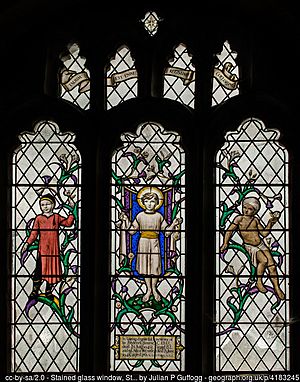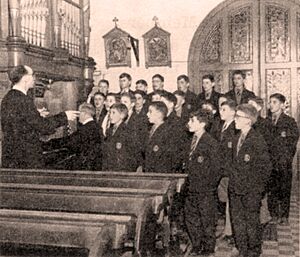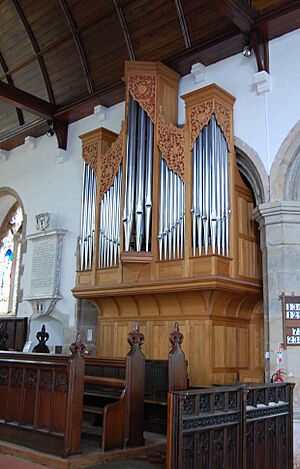St Dunstan's Church, Mayfield facts for kids
St Dunstan's Church is a historic church located in Mayfield, East Sussex, England. It was founded way back in 960 CE by St Dunstan, who was an important leader as the Archbishop of Canterbury. Today, it is a special "listed building," meaning it's protected because of its history and architecture. As of 2023, the church's leader was Fr Michael Asquith.
Contents
Church History
The first church here was likely made of logs. It was replaced by a stone building in the 12th century by the Normans, who were people from Normandy, France. In 1389, a big fire almost completely destroyed this stone church. Only the tower, a tall, narrow window (called a lancet window) in the west wall, and the bottom part of the north aisle (a side section of the church) survived.
The local people probably used a private chapel nearby until the church was rebuilt. This rebuilding happened between 1410 and 1420.
Changes Over Time
The church was damaged again in 1621 when lightning struck it. You can see how important the iron industry was in this area by looking inside the church. There are two cast iron tomb slabs set into the floor of the main part of the church, called the nave.
The oldest part of the church is the Tower, built in the 13th century. It has a small living area, the church bells, and a clock. Other parts of the church were mostly built in the 17th century, with changes made over many years. The church is well-maintained and has been improved a lot in recent years.
During the time of King Henry VIII, more work was done. The roof of the nave was made higher, and a clerestory was added. A clerestory is a row of windows high up on the wall, letting in more light. In 1657, a clock was put in by Thomas Punnett.
In the South Porch, decorative stone supports called corbels hold up a vaulted ceiling. A spiral staircase (called a newel staircase) leads to a room above, known as the Parvise Room. This room might have been used by a priest for prayer or by a sacristan, who looked after the church's things. In the 1800s, it was used as a cloakroom for a girls' school held in the church.
Inside the Church
The nave has four tomb slabs made from Sussex iron. The best-preserved ones belong to Thomas Sands, a wine cooper from London, and his grandson, also named Thomas Sands. The font, used for baptisms, is from 1666. The initials of the vicar at that time, Robert Peck, are carved on its eight-sided bowl. The pulpit, where sermons are given, is from the 17th century. It is decorated with carvings in a style called Jacobean.
Many of the choir stalls, where the choir sits, were from the 16th century. Some were repaired by the Mayfield School of Carving in the early 1900s. They also made the screen for the Lady Chapel, which has beautiful carvings that look like folded linen (called linenfold carving). The choir stalls were replaced in 2016 with new movable oak stalls.
The large east window has special glass from Munich, given by the Treherne family in 1869. In 1894, the old reredos (a decorated screen behind the altar) was replaced. The old one was carved by Walter Gale, the village schoolmaster, in 1750.
A window at the west end of the church honors Lt Gen Sir John Bagot Glubb, also known as Glubb Pasha. He was a soldier, scholar, and writer who led and trained Transjordan's Arab Legion from 1939 to 1956.
Church Bells and Memorials
In the 1970s, cracks in the tower walls meant that all the bells could not be rung at once. It took 14 years and £140,000 to fix the tower. The bells were then re-tuned at the Whitechapel Bell Foundry. The oldest bell was made by Thomas Giles in 1602. Other bell makers included Brian Eldredge, Richard Phelps, John Waylett, and John Taylor.
In the year 2000, a special concert was held. One hundred bell towers in France and Mayfield, England, rang their bells at the same time. This event was broadcast by the BBC.
Many of the memorials in the church are for the Baker and Kirby families. These families were important local ironmasters, meaning they owned ironworks. Georgina Weldon is buried in the Dalrymple family vault.
Church Music
St Dunstan's has a long history of Anglican Music. In 1731, it was known for its "skillful singing of the same Psalms" from a gallery at the west end of the church. The choir has grown to be one of the largest and most respected church choirs in the Diocese. They often travel to sing at Cathedrals and churches across the UK.
The Choir
The choir sings during the Choral Eucharist every Sunday when school is in session. They also sing for Choral Evensong once a month, usually on the last Sunday. Their schedule also includes singing at weddings and funerals when asked. They lead special services for Advent and Christmas carols.
The choir has many children and young people from the area. They join because the choir is known for its high-quality music and teaching. Many choristers have gone on to sing with famous choirs like Salisbury Cathedral Choir and The Sixteen. Some have even studied music at top universities like Oxford and Cambridge, or at music schools like the Royal Academy of Music.
In June 2019, the choir sang with Salisbury Cathedral Choir at Salisbury Cathedral. They performed pieces like Charles-Marie Widor’s Messe and an Easter Cantata by Bach.
The choir has worked with some of the country’s best church musicians. They even asked Malcolm Archer to write two new songs (anthems), which the choir performed for the first time with the composer leading them.
Recently, in December 2021, they performed parts of J.S. Bach’s Advent Cantatas, including ‘Wachet Auf’, with the Mayfield Festival Baroque Orchestra. In February 2022, they sang Choral Evensong at Chichester Cathedral. They performed the Magnificat and Nunc Dimittis in G by Henry Smart, which is rarely heard. In December 2023, they performed G.F. Handel's Messiah with the London Mozart Players. They have also visited other cathedrals like Southwark Cathedral and Rochester Cathedral. In August 2023, they sang Evensong at Westminster Abbey for World Humanities Day. Important guests like Crown Prince Alexander and Crown Princess Katherine of Serbia were there.
Directors of Music
- 1968-2004 Kenneth Pont
- 2004-2022 Andrew Benians
- 2022-2023 Jack Gonzalez-Harding
- 2023-2024 Thomas Hawkey-Soar (Interim)
- 2024- Lucy Piercy
The Walker Organ
In 1997, a new Walker Organ was installed at St Dunstan's. This new organ allowed for a wider range of music to be played. It also made it possible to have more organ concerts. Famous organists like Dame Gillian Weir, John Scott, Simon Preston, and Olivier Latry have performed here. In the 2018 festival, James O’Donnell, who is the organist at Westminster Abbey, also played.
The previous organ was bought second-hand in 1864 and made bigger in 1900. It was much smaller than the current organ.
When the new Walker Organ was planned, a lot of money needed to be raised. The church applied for a grant from the National Lottery. Even though the church members raised enough money themselves, they still received the Lottery grant because the application process had already started. This money was put into an Organ Fund, which is used to keep the organ tuned and in good condition.
Mayfield Festival of The Arts
The Mayfield Festival of Music and the Arts started in 1970. It was founded by Kenneth Pont, who was the director of music at St Dunstan's Church at the time. This festival happens every two years. Most concerts take place in the 15th-century St Dunstan's church or in the Old Palace. The Old Palace was once one of six mansions in Sussex that belonged to the Archbishop of Canterbury. It now has a concert hall built in 1930 by Adrian Gilbert Scott. These buildings are now part of Mayfield Girls School. The school's choirs often help by providing singers for the festival's large choral performances.
The festival began as a way to raise money for a new church hall for St Dunstan's. The vicar, Canon Donald Carter, and Kenneth Pont organized many events over two weeks. Even though the hall was never built, the festival has continued ever since.
People come from all over the South-East of England to hear performances in these historic places. Famous performers like John Ogdon, Peter Donohoe, James Galway, Evelyn Glennie, and Dame Janet Baker have performed at the festival.
From 1976 to 2002, Sir David Willcocks was closely involved with the festival. He conducted one of the two main choral works at every festival. He appeared 15 times with the Mayfield Festival Choir, conducting famous pieces like Bach's Mass in B minor and Mozart's Grand Mass in C minor.
Kenneth Pont retired as Festival Director in 2004. Neil Mackie CBE took over. In 2014, Jeremy Summerly became the Festival's Artistic Director. He is also the Director of Music at St Luke's Chelsea and a broadcaster for BBC Radio. He started the Oxford Camerata in 1984, and they often perform at the festival. In the 2022 Festival, they performed Thomas Tallis' Spem in Alium.
In 2018, the Festival held a competition for composers to write a cantata (a type of musical story) about the life of Saint Dunstan. This new cantata was meant to be performed in 2020 to celebrate the festival's 50th anniversary. Nicholas O’Neill won the competition. The cantata also includes music by Andrew Benians and Kenneth Pont. Jeremy Summerly wrote the story for the music. The first performance of the Cantata of St Dunstan finally happened in 2022, as part of the opening concert of the festival.
See also





